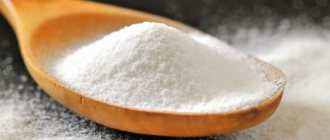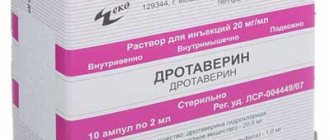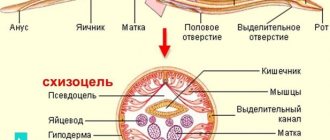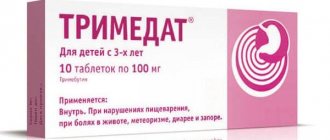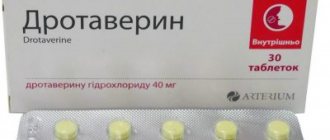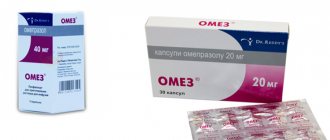Will motilium help with diarrhea?
The release form of the product is tablets, suspension (for newborns and small children) or lingual tablets.
How does domperidone work?
Domperidone blocks dopamine receptors in the upper digestive tract. This causes contraction of the muscles at the entrance to the stomach and relaxation of the muscles at the exit from it, and also enhances the peristalsis of the stomach itself.
Therefore, the use of Motilium for diarrhea is inappropriate. These actions speed up the passage of food through the stomach into the intestines, which helps prevent vomiting and reduce nausea, bloating and fullness.
Domperidone also prevents the backflow of food from the stomach into the esophagus.
Motilium also blocks dopamine receptors in the area of the brain that are activated by nerve signals from the stomach. Once activated, it sends signals to the vomiting center. Blocking dopamine receptors prevents nausea and vomiting.
What does Motilium help with?
This drug has the following indications for use:
- Stopping nausea and vomiting in adults and children.
- Relief of abdominal discomfort and bloating, feelings of fullness, acid reflux and belching.
Motilium is currently recommended for short-term treatment of vomiting and nausea, as its use is associated with the risk of serious cardiac side effects.
How to take the drug?
Dosage in adult patients:
- To relieve nausea and vomiting, patients over 16 years of age may take 1 tablet 3 times daily for 2 days.
- The tablet should be swallowed and washed down with enough water. Motilium should be taken before meals, since it takes longer for the drug to take effect when swallowed after a meal.
- You cannot take more than 3 tablets per day.
- You should not use Motilium for more than 2 days. If nausea and vomiting last longer, you should consult a doctor.
Directions for use in children:
- Domperidone syrup should only be given to a child as prescribed by a doctor.
- You need to take the drug strictly at the same time.
- For heartburn, Motilium should be taken 30 minutes before meals.
- Carefully measure the amount of syrup using a special syringe or measuring spoon.
Side effects
Frequent (develop in 1–10% of patients):
Uncommon (occurs in 0.1–1% of patients):
- Diarrhea.
- Decreased sexual desire.
- Anxiety.
- Insomnia.
- Headache.
- Rash or itching.
- Weakness.
- Pain or tenderness of the mammary glands.
- Increased breast milk production.
- Hives.
- Swelling of the face, tongue and throat (Quincke's edema).
- Excitation.
- Nervousness.
- Cramps.
- Uncontrolled movements of the arms, legs, face, neck, or tongue.
- Increased prolactin levels, which can lead to breast enlargement in men (gynecomastia) or cessation of menstruation in women.
- Difficulty urinating.
- Abnormal heart rhythm.
- Arrhythmia.
- Liver dysfunction.
When should you not take Motilium?
Like any drug, domperidone has its contraindications:
- Allergy or intolerance to any of the components of the drug.
- Pituitary tumor (prolactinoma).
- Intestinal obstruction or perforation.
- Black stools or blood in the stool may be a sign of gastrointestinal bleeding.
- Liver or kidney disease.
- Heart problems that show up on an ECG as a long QT interval.
- Heart failure.
- Low or high levels of potassium in the blood, low magnesium.
- Taking certain drugs that prolong the QT interval.
Domperidone should be taken with caution in people over 60 years of age. Motilium should be taken at the lowest possible dose.
Can Motilium be used by pregnant women and breastfeeding mothers?
There is currently no data on the safety of taking domperidone during pregnancy. Therefore, it should only be taken as prescribed by a doctor and in cases where the benefits outweigh the possible risks to the development of the fetus. You cannot use Motilium on your own for nausea in early pregnancy.
Domperidone passes into breast milk in small amounts that are most likely harmless to the baby. However, the instructions for use of the drug do not recommend its use in women who are breastfeeding unless the potential benefit to the mother outweighs any risk to the baby. If taking Motilium is necessary, it is better for the mother to stop breastfeeding for this time.
Motilium or Motilak - which is better?
Domperidone is found in many drugs, such as Motilium, Motinorm, Motilak and others. Having carefully studied the descriptions of these drugs, it is not difficult to understand what the difference between them is. Motilium is the original (branded) drug, and Motilak is its generic.
Patients and doctors have broken many lines in disputes about which product is better - branded or generic? The original drug is believed to be more effective in most cases, but it almost always costs more than the generic drug.
In addition, Motilak is available only in the form of lozenges, which means it is not suitable for small children.
Uncontrolled drug use is one of the huge problems of modern society. In conditions where every patient is his own doctor, when medications can be freely purchased at a pharmacy, the development of serious complications from taking medications has long been no surprise to workers in medical institutions.
One such drug that most people consider “harmless” is Motilium. In fact, this drug has quite dangerous side effects that can be life-threatening for the patient.
Professional skills: Colon hydrotherapy, treatment of gastrointestinal diseases
Many diseases are accompanied by dyspeptic disorders. Nausea and vomiting are often so severe that they cause dehydration. In such a situation, it is necessary to take specialized medications. The instructions for using Motilium state that this remedy helps to quickly eliminate painful symptoms. The main thing is to remember the specifics of using the drug.
Release forms
The drug is approved for use by people of all ages. In special cases it is used even for newborns. For each patient, you can choose the appropriate form of release of the drug. Motilium is produced in the form of:
- Tablets . They have a biconvex shape and a pleasant creamy color, covered with a thin shell. The section clearly shows a small white core. Labeling is applied to each coated tablet of 10 mg, 30 pcs. "Johnson." By this inscription they can be easily distinguished from counterfeit products.
- Lozenges for resorption . They are small in size and round in shape. Pure white or with a slight cream tint. The medicine in lozenges is packaged in blisters and cardboard boxes.
- Suspensions . Widely used in pediatrics. The product has a uniform consistency and pleasant taste, so kids do not refuse to take it. Children's Motilium suspension is packaged in 100 ml bottles. It comes with a special syringe that allows you to accurately dose the syrup.
Source: https://limto.ru/pomozhet-li-motilium-pri-ponose/
Who is it contraindicated for?
This drug is not suitable for everyone. There are people for whom it is contraindicated. For example, for those who have:
- bleeding in the gastrointestinal tract;
- intestinal obstruction;
- disorders of the liver and kidneys of varying severity;
- intolerance to the components of the drug;
- prolactinoma;
- heart failure and underlying diseases of the cardiovascular system.
The instructions for the use of Motilium during pregnancy indicate that in the absence of the accompanying symptoms listed above, the use of the drug is permitted. However, it should be taken with caution and only after consulting a doctor.
Motilium for diarrhea, poisoning and dysbiosis: treatment regimens
To improve the functional state of the digestive system, medications are prescribed that normalize intestinal motility. In case of poisoning, Motilium is used for complex treatment. The medication helps reduce the manifestations of dyspeptic syndrome.
Useful properties of Motilium for poisoning and diarrhea
The use of Motilium for diarrhea and after food poisoning is justified due to its pathogenetic effects. The main component of the drug is domperidone. The compound acts on dopamine receptors in the brain, which are responsible for regulating peristalsis (wave-like movements of the walls) of the stomach and intestines. Due to the mechanism of action, several effects are realized:
- Reducing the severity of nausea.
- Antiemetic effect.
- Accelerates gastric emptying.
- Reducing bloating (flatulence).
- Faster elimination of intestinal contents.
In case of food poisoning, the antidiarrheal effect (the effect of reducing the severity of diarrhea) is not realized immediately, but over time, which is necessary to free the digestive system from toxins.
Rules and treatment regimens
Correct use of a medication involves its administration in accordance with medical indications, as well as in combination with other medications. The regimen and dose of the medication depend on the nature and severity of the pathology.
Therapy of poisoning
The term poisoning implies the entry of toxic compounds into the digestive system. They first cause functional dyspepsia, then are absorbed into the blood and lead to general intoxication. The nature and severity of changes, as well as the direction of therapeutic measures, depend on the type of toxin that has entered the intestines.
Food poisoning
Food poisoning develops as a result of the consumption of poor-quality food products, in which a large number of microorganisms and their waste products have accumulated.
This is accompanied by severe nausea, vomiting, stool upset, bloating and general intoxication with fever, body aches, and headache. Unlike an intestinal infection, signs of poisoning develop within a few hours after eating.
Effective use of the medicine requires the obligatory implementation of several rules:
- Before using any medications, gastric lavage is performed. At home, this can be done the “restaurant way”. A person drinks 1 liter of clean water at room temperature, after which he provokes vomiting by irritating the mucous membrane of the pharynx with his fingers. The procedure is repeated several times until clean water leaves the stomach.
- Intestinal sorbents are taken to bind and quickly remove toxins from the lumen of the hollow structures of the digestive tract. The most common remedies include Activated carbon (1 tablet per 10 kg of body weight), Enterosgel (1 tablespoon for an adult), Sorbex (1-2 tablets per dose).
- After taking enterosorbents, the use of Motilium is allowed. The recommended dose for adults is 1 tablet 3 times a day (daily dose - 30 mg), the duration of therapy after food poisoning is usually no more than one day.
- To reduce the functional load on the stomach and intestines, it is not recommended to eat food within 8 hours after food poisoning; you are allowed to drink still mineral water and dried fruit compote. Then the diet can include biscuits, liquid rice porridge (“mush porridge”), boiled in water.
Using the medication after food poisoning will quickly normalize the functional state of the gastrointestinal tract. It is very important to follow the sequence of events. If you do not first rinse the stomach and take intestinal sorbents, then suppressing vomiting with Motilium will provoke the retention of toxins and their absorption into the blood.
Alcohol intoxication
Taking large amounts of alcohol leads to disruption of the functional state of the digestive system and other organs. Intoxication is accompanied by severe nausea, vomiting, and abdominal pain, which is cramping in nature. Proper assistance includes several successive stages:
- Gastric lavage to remove residual alcohol and toxic products of its breakdown. Against the background of intoxication, bile can be thrown into the stomach cavity, which has a negative effect on the mucous membrane.
- Taking intestinal sorbents in accordance with the therapeutic dosage.
- 1 hour after using enterosorbents, you can take Motilium tablets. The mode of use involves taking 3 tablets within one day.
- The use of multivitamin preparations and succinic acid to improve the course of metabolic processes in the liver and other organs.
It is very important to follow the sequence of stages of providing medical care. Taking an antiemetic before gastric lavage will cause the retention of toxic compounds in the hollow structures of the digestive system.
We treat loose stools of unknown etiology
Diarrhea is a protective mechanism by which the body speeds up the release of toxins from the intestinal cavity. If the cause of diarrhea cannot be reliably established, then at the initial stages treatment should include several measures:
- Colon lavage with a cleansing enema.
- Taking intestinal sorbents.
- Rehydration of the body - restoration of the level of fluid and mineral salts.
In the future, it is necessary to diagnose the causes of diarrhea, which will allow selecting appropriate etiotropic therapy. The use of Motilium is possible in a short course for diarrhea, which is accompanied by nausea and vomiting.
Motilium for vomiting: regimens and dosages
Depending on the age of the patient and the dosage form of the drug, several regimens and dosages are used in accordance with the instructions:
- Tablets for adults – 1 tablet 3-4 times a day, no more than 1 week.
- Sublingual tablets – 1-2 tablets 3-4 times a day, the course of treatment lasts 7 days.
- Suspension - the dose for children from birth to 12 years is 0.25-0.5 ml 3 times a day, the duration of use should not exceed 1 week.
Does Motilium help with nausea?
The active component of the drug, domperidone, acts on dopamine receptors in the brain, thereby increasing peristalsis of the esophagus and stomach. As a result, the unpleasant subjective feeling of nausea is reduced. The drug is able to stop vomiting.
What to do when Motilium does not help with digestive disorders?
The absence of a therapeutic effect after starting to use the medicine indicates a severe course of the disease or poisoning. In this case, you should stop taking the tablets or suspension and consult a doctor.
Emergency Medical Conditions
Some changes in the digestive system are urgent conditions and require urgent treatment. They include the following manifestations:
- Severe abdominal pain.
- The appearance of blood in the stool.
- Lack of bowel movements for a period of time exceeding 2 days.
- Vomit has a “coffee grounds” appearance, which is a sign of bleeding in the stomach.
- A sharp deterioration in general condition with pale skin and weakness.
Taking Motilium for diarrhea and poisoning can have a positive effect only if the drug is used correctly. The appearance of doubts or signs of deterioration of the condition is grounds for contacting a doctor.
Source: https://mfarma.ru/pankreatin/pomogaet-li-motilium-pri-otravleniyah-i-diaree
Indications for use
- Nausea.
- Vomiting.
- Feelings of fullness in the stomach, bloating.
- Painful sensations in the epigastric abdomen.
- Flatulence.
- Belching, including with the presence of gastric contents.
- Heartburn.
The medication can be used for nausea, vomiting, belching of any origin: due to poisoning, infection, functional, organic disorders of the digestive system, drug intoxication.
Motilium is also prescribed in cases where vomiting and nausea occur due to the use of dopamine activity stimulants in Parkinson's disease (for example, Levodopa, Bromocriptine).
Motilium for diarrhea
Stress, poor diet, intestinal infection and much more can cause indigestion. To eliminate the condition accompanied by loose stools, bloating, flatulence, nausea, vomiting and cramps, Motilium comes to the rescue.
pharmachologic effect
Motilium helps against diarrhea by stimulating the functions of the gastrointestinal tract. This medication is used to treat frequent loose stools, eliminate nausea and vomiting. But for effective use, before undertaking any treatment, you should carefully study the instructions and dosage regimen for adults and children.
The peculiarity of the drug is that it belongs to the group of antiemetic drugs, but at the same time improves intestinal motor function and effectively copes with diarrhea. This is due to the fact that the medication used for diarrhea significantly increases the tone of the sphincter of the lower part of the esophagus.
Compound
In the drug Motilium, used for diarrhea, the active substance is domperidone, the main property of which is a neuroleptic effect, but without adverse side effects. The use of a drug based on domperidone stimulates the natural production of the element prolactin in the body.
Auxiliary components are:
- Corn starch;
- Polividone;
- Lactose monohydrate;
- Cotton seed oil;
- Fine cellulose;
- Magnesium stearate;
- sodium lauryl sulfate;
- Pregelatinized starch.
Due to the pronounced therapeutic effect, the functioning of peristalsis improves, food from the stomach, toxins and wastes are quickly released. Thanks to this, food debris does not linger in the intestines, the process of rotting is prevented, this eliminates heartburn, nausea, and gas formation, which most often accompany diarrhea.
Release form
The medicine Motilium, which is used for diarrhea, is offered for sale in three main forms:
- Lozenges;
- Tablets in food coating;
- Oral solution.
Each release form differs in dosage and concentration of the active substance.
Indications for use for adult patients
The medicine helps to effectively cope with the following symptoms:
- Intestinal disorder;
- Feeling of full stomach;
- Flatulence;
- Nausea;
- Consequences of food poisoning;
- Vomiting;
- Epigastric pain;
- Spasms during bowel movements.
The product also significantly reduces the acidity of reflux and belching.
The use of Motilium in the treatment of diarrhea in adults
Often, the suspension is prescribed to relieve symptoms of gastritis, eliminate painful spasms in the lower intestine. Motilium also eliminates heaviness and tightness in the abdomen during diarrhea, and normalizes motility. To relieve a particular disease, a specific dosage of medication and an individual course of administration are needed.
Recommended dosage
To eliminate diarrhea, adult patients should take:
- Pills. 1-2 pcs. 3 times a day, swallow and drink with plenty of liquid, the permissible daily dose is 80 mg.
- Lozenges. 1-2 pcs. (10-20 mg) 3 times a day, half an hour before meals.
- Suspension. Take 10-20 ml 3-4 times, take a maximum of 80 ml per day.
Important! Motilium for diarrhea should be taken before meals, the course should be continued for no more than 2 days. If the symptoms do not go away or the condition does not improve, you should consult a doctor.
Contraindications
The medicine is quite powerful and has certain contraindications for use:
- Stomach bleeding;
- Breast oncology;
- Malignant brain tumors;
- Individual intolerance to the drug substances;
- Glaucoma;
- Epilepsy;
- Body weight less than 35 kg;
- Hypersensitivity.
If allergic symptoms appear to one of the components of the medication, you must stop taking the medication and consult a specialist.
Important! Patients with liver dysfunction should take Motilium for diarrhea under medical supervision.
Possible side effects
Violation of the prescribed dosage and dosage regimen can lead to the following side effects:
- Drowsiness;
- Loss of coordination;
- Trembling in the limbs;
- Irritability;
- Minor cramps.
To eliminate adverse effects, it is recommended to immediately take activated charcoal and antihistamines.
Use during pregnancy
Motilium is not recommended for diarrhea during pregnancy, because There is insufficient data on its effect on the fetus.
Therefore, along with the fact that the medicine has many indications and helps to cope with various painful conditions, its use during pregnancy is allowed when the expected effect outweighs the possible risks.
To date, there is no confirmed data on the effect of medication on a child during breastfeeding. Therefore, if the drug is used in the treatment of diarrhea, feeding should be stopped at this time.
Use in the treatment of loose stools in children
For diarrhea, Motilium, based on domperidone, is often used in the treatment of gastrointestinal problems in children.
Recommended dosage of Motilium for the treatment of diarrhea in children
When calculating the dosage, it is worth knowing that a child can consume a maximum of 2.4 mg per 1 kg of body weight per day, but not more than 8 pieces. per day.
- For children under 5 years of age and weighing less than 35 kg, Motilium suspension is prescribed for diarrhea at a rate of 0.25-0.5 mg per 1 kg of weight. Divide all the liquid into 4 doses per day.
- For children from 5 to 12 years old weighing more than 35 kg, the following is prescribed:
- Coated tablets – 0.25-0.5 per 1 kg of weight, divided into 3 doses per day.
- Lozenges 1 pc. (10 mg) take 4 times a day.
- Calculate the suspension at 0.25-0.5 per 1 kg of body weight and divide the resulting solution into 4 doses.
- For adolescents over 12 years of age, the drug is prescribed in the following dosage:
- Tablets 2 pcs. (10 mg) maximum 4 times a day.
- Drink the suspension 20 ml 3-4 times a day.
To improve the absorption of the drug in children, it is recommended to take it before meals, the maximum course of treatment is 28 days, subsequent doses should be prescribed by a doctor. If children have impaired kidney or liver function, the dose is reduced by half.
When instant mint-flavored capsules are used as a treatment, they are placed under the tongue until completely dissolved.
To improve the speed of action, a regular tablet must be taken with a sufficient amount of liquid (1-2 glasses).
Indications for use
Important! It is not recommended to take the drug on your own; without consulting a doctor, it is difficult to diagnose the seriousness of a small patient’s condition.
Motilium for diarrhea in a child can be used in a number of the following situations:
- Regurgitation;
- Stomach colic;
- Frequent bowel movements;
- Increased gas formation;
- Bloating;
- Heartburn.
If you do not follow the instructions or change the dosage or duration of treatment yourself, the drug may cause some side effects in children:
- Headache;
- Conjunctivitis;
- Decreased appetite;
- Swelling of the mammary glands (in girls over 10 years old);
- Cramps in the stomach;
- Hives.
Analogs
Today there are many drugs on the pharmaceutical market used to combat diarrhea:
- "Motilak";
- "Domidon";
- "Motinol" and many others.
One of the most popular is Motilak for diarrhea; the drug improves intestinal function and prolongs peristalsis.
But both medications have their own characteristics; Motilak for diarrhea is somewhat different from its analogues. It differs in that it is offered only in tablets, so it is not always convenient to take, especially for children; mint tablets and suspension taste much more pleasant.
Motilium is slightly more expensive than Motilak, but the first drug is an original patented product.
The composition and pharmacological action of the two drugs are identical, but Motilak has a greater number of contraindications and side effects; potato starch is used as an additional element, unlike the first drug, which contains corn starch; this feature will be useful for allergy sufferers.
Motilium is one of the potent, highly effective drugs for diarrhea, and allows you to quickly eliminate the causes and symptoms of the disease. But the medication should be used with caution, especially for children!
Source: https://ponosnevopros.ru/lechenie/motilium.html
When and how to take Motilium?
Motilium is an effective antiemetic. A characteristic feature of the drug is a decrease in the brightness of dyspeptic symptoms (vomiting or heartburn, nausea or flatulence, a feeling of fullness, as well as stomach pain after a meal), which are associated with impaired transportation of products from the stomach further into the intestines.
Pharmacokinetics
Motilium is quickly absorbed from the gastrointestinal tract. Maximum accumulation in plasma is observed an hour after a meal. The drug is characterized by fairly low bioavailability - about 15%. If the patient has low acidity, the absorption of domperidone is markedly reduced.
The active substance binds to blood plasma proteins within 91–93%. It is quickly distributed in tissues, but at this time it is weakly concentrated in the brain area. Metabolism of the drug components is carried out by the intestines and liver.
Motilium is excreted in feces up to 66%, in urine - about 33%, unchanged. The half-life of the drug is 7–9 hours. In patients diagnosed with severe renal failure, this figure increases even more.
Indications
According to the instructions, the medicine is indicated:
- to block the manifestations of gastric hypotension, the chronic phase of gastritis, reflux esophagitis, which appear due to the retention of products in the organ and their slow movement into the intestines:
- with heaviness or fullness of the stomach due to a meal;
- in a situation with pain in the stomach area after lunch;
- with flatulence;
- when belching, nausea or vomiting appears.
For children, the instructions for Motilium suggest its use in the form of a suspension, recommended for vomiting or nausea.
Dosage regimen
Regarding Motilium, the instructions for use for children with vomiting state that they must be taken before a meal, since after it the absorption of domperidone slows down significantly.
For the adult category (adolescents over the age of twelve), the dose is prescribed in a dose of up to two tablets, but 3-4 times daily, not exceeding 80 mg per day.
For children, Motilium for vomiting is prescribed as a single tablet, three times a day. If the desired effect is absent, the indicated volume of the drug is allowed to be doubled. Tablets are recommended for patients weighing more than 35 kg. For children, a suspension is better, and dissolvable tablets are prescribed in the presence of chronic dyspepsia.
If the child is over 5 years old, the dose is 10 mg 3 times a day. The same number of pills is recommended for adult patients. It is advisable to drink the drug a few minutes before a meal.
Sometimes a doctor in a specific situation recommends taking medication before a night's rest. The suspension is calculated at 2.5 ml per 10 kg of child’s body weight. It is allowed to double only after the baby reaches one year of age. The maximum permissible concentration is 2.4 mg/day per kilogram of weight.
Side effect
The use of Motilium for diarrhea in a child or other concerns of a similar nature may be accompanied by the appearance of adverse reactions:
- seizures;
- nervousness;
- transient intestinal spasm;
- drowsiness;
- anaphylactic shock;
- headache;
- angioedema;
- hives;
- allergic type reactions;
- rash;
- dry mouth;
- itching;
- increased diarrhea;
- gynecomastia;
- amenorrhea;
- problems with the organs of vision;
- urinary retention.
According to clinical studies, the following adverse reactions were identified that were observed in 1% of patients using Motilium:
- problems with libido, as well as mammary glands (their enlargement, increased sensitivity, soreness, swelling, discharge of a substance);
- disruptions in the menstrual cycle;
- disturbances in the secretion of milk by the glands.
Contraindications for use
Any form of medication is contraindicated for use if the patient is diagnosed with the following pathologies or conditions:
- compaction of the pituitary gland, which produces prolactin;
- increased prolactin levels in the circulatory system;
- simultaneous use with medications such as Voriconazole or Erythromycin, Ketoconazole or Amiodarone, as well as Fluconazole with Clarithromycin;
- intestinal or stomach bleeding;
- intestinal obstruction of a mechanical nature;
- patient weight less than 35 kg;
- individual intolerance to medication substances;
- children's age up to 1 year.
It is necessary to use the medicine with extreme caution during all trimesters of gestation of the desired fetus.
Use during pregnancy and breastfeeding
When carrying a child, Motilium helps to relieve unpleasant symptoms - nausea and vomiting, one of the consequences of toxicosis. However, due to the incomplete study of the effect of the drug on the fetus, its use without a full examination and prescriptions from a specialist is not recommended.
The active substance penetrates too quickly into the circulatory system and reaches the organs, including penetrating the placenta, entering the embryo’s body. This can lead to the child losing weight.
Motilium also has a negative effect on the baby during breastfeeding. Getting into the baby's body through milk, the substances of the drug can affect bloating, cause vomiting, diarrhea, and colic. For this reason, it is better not to risk taking the medicine, replacing it with a safe remedy.
Use in children
Instructions for children regarding the use of Motilium suspension for diarrhea state that the drug can be prescribed to children for various manifestations of hypotension of the gastric walls, which are associated with difficulties in the evacuation of products from the stomach into the duodenum.
As a symptomatic medication, such a drug is prescribed to relieve dyspeptic disorders caused by the following phenomena:
- nutritional disorders of nursing mothers;
- motion sickness in transport (Motilium quickly helps with vomiting in a child);
- improper complementary feeding in the first year of a newborn’s life (the instructions for Motilium regarding the use of a suspension for children with diarrhea directly indicate this);
- carrying out medical procedures (endoscopy);
- taking certain medications that provoke cyclic vomiting.
The drug can be used during the neonatal period, but strictly as prescribed by the attending physician and under his supervision.
For infants 2–3 months of age, Motilium is recommended for extensive and frequent regurgitation. The medication must be taken before feeding. It cannot be mixed with milk or complementary foods.
Motilium for vomiting in a 3-year-old child is prescribed only in the form of a suspension. Then its dosage is 0.25–0.5 ml per kilogram of the baby’s weight.
The amount of suspension is measured using a special dispenser syringe with dosage divisions marked on it, taking into account the child’s body weight (in increments of 1 kg).
The medicine is prescribed before meals (15–30 minutes before it) three times a day.
Sometimes it is possible to increase the amount of the drug, but it is necessary that it does not exceed the daily volume (2.4 ml per kilogram of weight). If the child is over 5 years old, but body weight does not exceed 35 kg, then the dosage is set in a similar amount.
For children of the older age group, the drug is prescribed according to the following scheme:
- in the period of 5–12 years, you should take a tablet before each meal (4 times);
- after the age of twelve, 2 tablets are prescribed, but only three times a day.
The duration of the therapeutic course depends on the severity of the symptoms. The minimum duration of a therapeutic course for children is limited to a term per week.
Motilium is prohibited for use if the child has a pathology associated with dysfunction of prolactin synthesis (hyperprolactinemia). An absolute contraindication is also prolactinoma, a tumor of the anterior pituitary gland, which is often benign in nature.
Parents are obliged to scrupulously monitor compliance with the dosages recommended by the pediatrician, since exceeding them can provoke serious consequences:
- speech disorder;
- convulsive syndrome;
- confusion;
- violation of spatial orientation.
If you unintentionally exceed the prescribed dose, you must immediately organize gastric lavage. For the procedure, you need to use a saline solution, and then give the child any sorbent to drink. After providing emergency care, you should definitely consult with a specialist.
special instructions
If it is necessary to combine Motilium with antisecretory or antacid medications, then the latter should be taken not before a meal, but after it.
This means that the simultaneous use of such medications with Motilium is prohibited.
Since the tablets of the described drug are coated with a film that contains lactose, the drug should not be prescribed to patients with intolerance to this substance, galactosemia, or dysfunction of galactose absorption.
Due to the high degree of processing of domperidone by the liver, Motilium should be used cautiously if liver failure is diagnosed. Since a small percentage of the medication is excreted unchanged by the kidneys, adjustment of the prescribed single dose in case of renal failure is completely meaningless and is not required.
But with a repeated course of treatment, the frequency of administration must be reduced to a single or twice daily dose. Sometimes there is a need in such a situation to even reduce the previously prescribed dose. When long-term therapy is performed, the patient must be regularly monitored by a specialist.
Overdose
In case of unintentional overdose, patients exhibit the following symptoms:
- drowsiness;
- excessive excitement;
- convulsions;
- spatial disorientation;
- consciousness suddenly changes;
- extrapyramidal reactions (speech dysfunction, tremor, noticeable tics).
For therapy in case of overdose, it is necessary to perform a one-time gastric lavage, after which you need to take any of the sorbents. In the future, when such a need arises, cholinergic and antihistamine medications, drugs against parkinsonism, and drugs to stop developing extrapyramidal reactions are prescribed.
Drug interactions
Anticholinergic drugs, Cimetidine, and sodium bicarbonate significantly reduce the severity of the therapeutic effect of the drug described.
With simultaneous use of Motilium with Fluconazole, Ketoconazole, Itraconazole, Coriconazole, Erythromycin, Clarithromycin, Amprenavir, Verapamil, Atazanavir, Aprepitant, Fosamprenavir, Diltiazem, Indinavir, Saquinavir, Telithromycin, Nelfinavir, Nefazodone, Ritonavir and Amioda By contrast, the effect of the first is significantly enhanced.
Erythromycin with Ketoconazole, if their use coincides with Motilium, changes the ECG picture, but it returns to normal soon after discontinuation of such medications.
Storage conditions and periods
It is recommended to store the medicine in a dark and dry place, out of reach of children. The optimal temperature for tablets and suspension is 15–30°C.
It is allowed to safely use a medicine released before the 5-year statute of limitations expired. After this date, the use of the medicine is prohibited.
